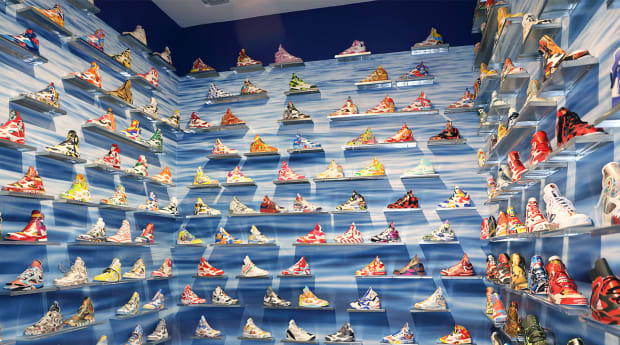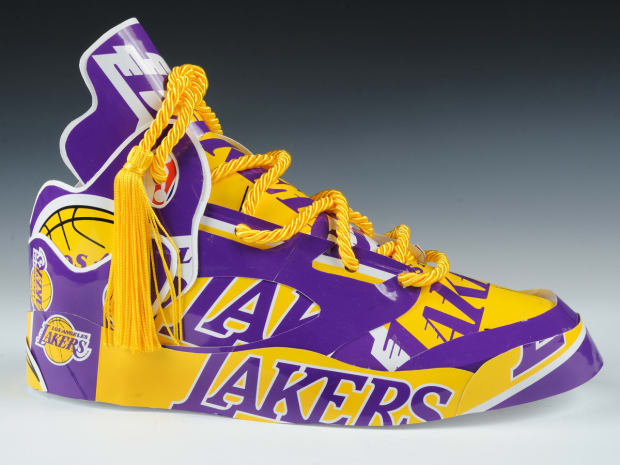Artist Andy Yoder repurposed everyday objects to make Air Jordan 5 sculptures inspired by the thousands of shoes that washed up across the Pacific Ocean after a storm hit several cargo containers in 1990.
In May 1990, the container ship Hansa Carrier was caught in a sudden storm midway between Seoul, South Korea, and Seattle. Storm waves swept 21 40-foot cargo containers, five of which held more than 61,000 Nike sneakers, into the Pacific Ocean. In the process, thousands upon thousands of Nike Air Jordan 5s, totaling more than $7 million in value in today’s dollars, were knocked off board.
Over the ensuing months and years, the untied sneakers would wash up on the shores of Vancouver, Oregon and Hawaii, among other locales. In effect, the “Great Shoe Spill of 1990,” as it was later dubbed, became an ideal natural experiment for oceanographers looking to study the currents of the Pacific. “It has been a real bonus to our work,” James Ingraham Jr., who worked for the National Marine Fisheries Service and was one of the two main oceanographers who studied the spill, said in 1992. It was also a boost to sneaker collectors, who scheduled frequent swap meets in an attempt to create Nike pairs.
Revisiting the spill 30 years later, artist Andy Yoder has crafted a mock showroom, repurposing everyday objects to make Air Jordan 5 sculptures. Dozens of sports posters were used to cover sneakers, some of which feature Lakers, Ohio State and Rams iconography. The others feature objects much of which he foraged from recycling and trash bins.
“It’s such a powerful symbol,” says Danny Lichtenfeld, the director of the Brattleboro Museum & Art Center in Vermont. “And a great kind of canvas.”
The sneakers are now on view at the Brattleboro Museum in Overboard, a new installation-based show. Sports Illustrated recently caught up with Lichtenfeld to discuss the Air Jordan 5’s impact on sneaker culture, the Great Shoe Spill itself and the connections between sports and art.
The following conversation has been edited for length and clarity.

Sports Illustrated: How did you find out about the sneaker sculptures?
Danny Lichtenfeld: I found out about this body of work because I follow the artist on Instagram. And when he first started making these sneakers, I saw a couple of pictures and just felt like we absolutely have to show them at our museum. Personally, as someone who works in the arts but is also a sports fan, I love when we have options to bridge those worlds. This installation takes an iconic symbol of sports culture, namely the Air Jordan 5s, as well as other sports paraphernalia and memorabilia, and elevates it to high art in a museum setting. It takes those materials and turns them into this really fun and visually amazing work. It’s also a really thought-provoking exhibit that extends beyond sports and goes into other aspects of life, like fashion and consumer culture and sneaker culture and discussions about the health of the oceans.
SI: What jumps out to you about the use of the Air Jordan 5s in these works?
DL: I think that’s what’s so brilliant about this. I’m hard-pressed to think of some other object that is laden with and is so tied to sports culture and is such a powerful, iconic symbol as Air Jordans. The Air Jordan just has a symbolic significance that goes beyond sports. And in fact, Air Jordans helped give rise to sneaker culture. The identity of Air Jordans has also moved into other aspects of life, like music and fashion. Sneakers after that have become these high-fashion and culturally important objects. That all traces back to the Air Jordan. It’s such a powerful symbol. And a great canvas.
SI: Had you previously heard about the spill?
DL: No, I hadn’t. Andy told me about it, and the fact that I wasn’t aware of it gave me confidence that people would be intrigued. It was just like a bonus finding out that it has this really cool historical reference in its relationship to environmentalists and the health of the oceans. But looking at the pieces, I also got a ton of confidence in the idea that you don’t need to know the whole backstory or even be necessarily all that interested in it to appreciate the work and find it interesting.
SI: How do you view the connections between the sports world and the art world?
DL: Well, I think one place where those worlds really intersect is around collecting. There’s such an intense world of sports memorabilia collecting, and there’s also a robust world of art collecting. That’s one place where those worlds definitively merge. And I think this exhibit references that and it engages with that in so far as these objects have a sneaker culture significance, but they are also significant in other ways.

SI: What is the significance of the materials used in these sneaker sculptures?
DL: One major aspect of the materials relates to ideas of consumer culture and the incident that sparked Andy’s interest. Broadly speaking, he’s using found materials and repurposed materials and memorabilia and recycling packaging materials. But with a real artful eye and a real artist’s talent for picking the right things and utilizing them in just the right way to make these visually amazing objects. But the works all have these references to consumerism and consumer culture and raise questions about consumer culture and what we’re doing for the planet. Then just more specifically, I think it’s cool to have these vintage posters promoting the Brattleboro ski jump or the Lakers or Ohio State. But it also doubles down on the sports references in the materials themselves, which I think is also very unique.